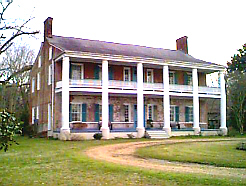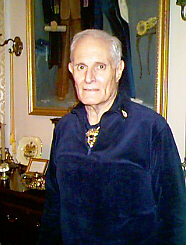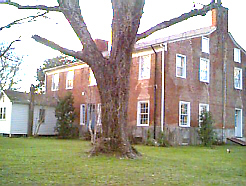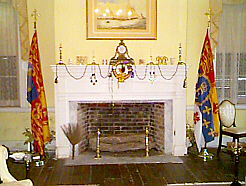 While staying in Natchez, in a trailer park without Internet hookup, Laura decided to
utilize the next most effective
While staying in Natchez, in a trailer park without Internet hookup, Laura decided to
utilize the next most effective  information system: the
Laundromat. On her trip there
she struck up a conversation with a lady, who had just visited an
old mansion under the control of the most unusual character she had met in the south.
That was enough for Laura. She then plotted a course to Springfield Plantation for the next
day. Located on State Route 553, 12 miles west off the Natchez Parkway, North of
Natchez, and marked by a very small tarnished sign at the driveway entrance.
Springfield Mansion
information system: the
Laundromat. On her trip there
she struck up a conversation with a lady, who had just visited an
old mansion under the control of the most unusual character she had met in the south.
That was enough for Laura. She then plotted a course to Springfield Plantation for the next
day. Located on State Route 553, 12 miles west off the Natchez Parkway, North of
Natchez, and marked by a very small tarnished sign at the driveway entrance.
Springfield Mansion
 was different in all respects to the homes restored in downtown
Natchez. With no formal parking lot,
was different in all respects to the homes restored in downtown
Natchez. With no formal parking lot, and no signs to the contrary, we parked on the
grass by the side of the house. In approaching the front of the house, a feeling of
loneliness crept over me. Maybe it was the dreary day we had picked or the rustic
exterior appearance. I half expected to find the front door locked and no one at
home, but nothing had prepared us for the eccentric Arthur E. LaSalle. A man light
in stature and many in years, who met us at the door. For the next three hours we
were treated to an exclusive view into the life and history of the house, and this
fascinating individual.
and no signs to the contrary, we parked on the
grass by the side of the house. In approaching the front of the house, a feeling of
loneliness crept over me. Maybe it was the dreary day we had picked or the rustic
exterior appearance. I half expected to find the front door locked and no one at
home, but nothing had prepared us for the eccentric Arthur E. LaSalle. A man light
in stature and many in years, who met us at the door. For the next three hours we
were treated to an exclusive view into the life and history of the house, and this
fascinating individual.  The house was built between 1786 and 1791, during the Spanish domination of
Mississippi, then known as West Florida, by Thomas Marston Green Jr., a wealthy
planter from Virginia. Springfield is one of
The house was built between 1786 and 1791, during the Spanish domination of
Mississippi, then known as West Florida, by Thomas Marston Green Jr., a wealthy
planter from Virginia. Springfield is one of the first houses in America to have a full
colonnade across the entire facade and is the first such mansion to be built in the
Mississippi Valley. Here in 1791 Andrew Jackson married Rachel Robards, which
made Springfield the setting for one of early America's most famous and later tragic
stories of love and devotion. The combination of this historic event and the major
architectural significance of this
house makes Springfield one of the country's most
notable landmarks.
the first houses in America to have a full
colonnade across the entire facade and is the first such mansion to be built in the
Mississippi Valley. Here in 1791 Andrew Jackson married Rachel Robards, which
made Springfield the setting for one of early America's most famous and later tragic
stories of love and devotion. The combination of this historic event and the major
architectural significance of this
house makes Springfield one of the country's most
notable landmarks.
